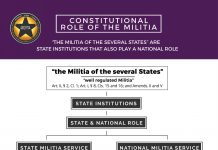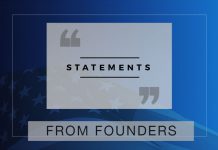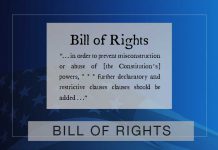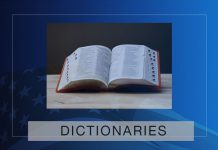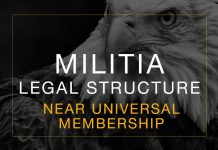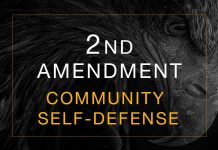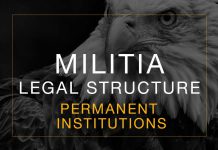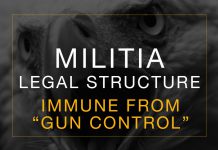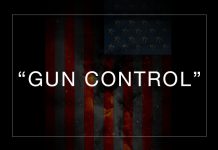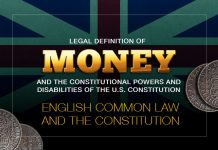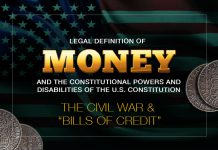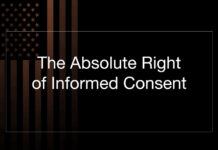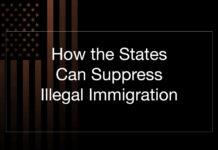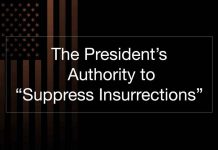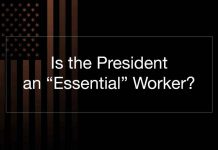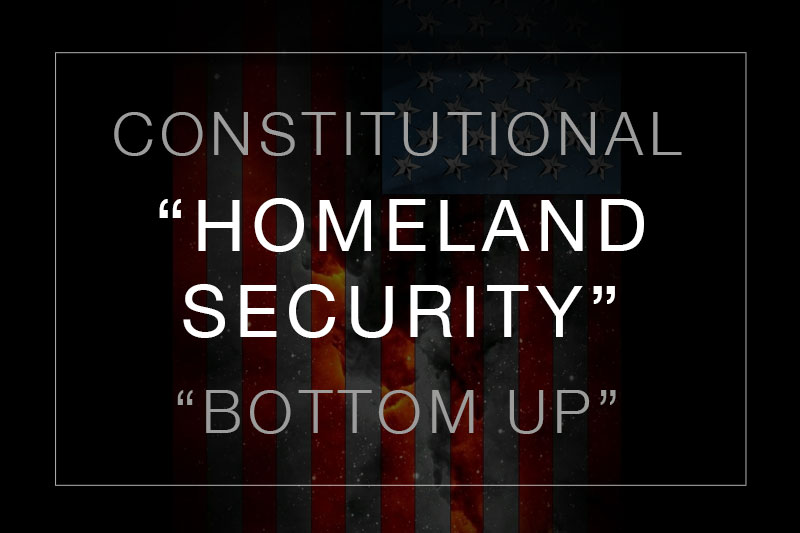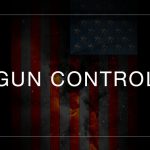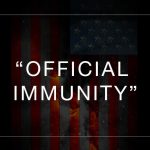Last Updated on October 28, 2021 by Constitutional Militia
A short while ago, a friend of mine who is an ardent advocate in “social media” of the entire Second Amendment—including its first thirteen words, “[a] well regulated Militia, being necessary to the security of a free State”—related a verbal altercation he had with a proponent of the so-called “individual-right theory” of the Amendment, which focuses exclusively on its last fourteen words, “the right of the people to keep and bear Arms, shall not be infringed.” This fellow chided my friend on the grounds that, were “the right of the people to keep and bear Arms” tied in any manner whatsoever to the Militia, tens of millions of Americans now capable of exercising “the individual right” with respect to some (albeit not all) kinds of firearms could (and probably would) be denied a right to possess any firearms whatsoever, because they could (and probably would) be excluded from the Militia. Recognizing this complaint as the product of a variety of industrial-strength ignorance that afflicts all too many Americans today, I felt it incumbent upon me to post a rejoinder.
A. To put it most charitably, “the individual-right theory” of the Second Amendment is a linguistic and legalistic delusion of people who suffer from a peculiar sort of illiteracy. For, inasmuch as it derives from the last fourteen words of the Amendment, without reference to the first thirteen, it violates the fundamental—indeed, the very first—rule of constitutional law (as well as of English grammar), that all the words and phrases in each provision of the Constitution (or in an ordinary English sentence) must be construed together and interdependently, as a coherent whole.
Humans being the aggressively argumentative animals they are, it is surely possible for someone to contend that no inextricable relationship—whether linguistic, logical, or legal—should be taken to exist between the first thirteen words of the Second Amendment, on the one hand, and the last fourteen words, on the other. The plausibility of any such contention would be nil, however, inasmuch as it would compel the conclusion that America’s Founders were extraordinarily poor draftsmen (or perhaps that English was not their native language). Worse yet, to say (as my friend’s antagonist did) that the Amendment’s first thirteen words should not be considered at all, would defame the Founders as brainless bumpkins indeed. If one is entitled to deride Judge Harvey Wilkinson’s arrogantly asinine attribution of “profound ambiguities” to the Second Amendment in Kolbe v. Hogan, 849 F.3d 114, 150 (4th Cir. 2017) (concurring opinion), how much more should one ridicule the assertion of touts for “the individual-right theory” that the Second Amendment in its entirety is confused to the point of self-contradiction, and that only by editorially excising its first thirteen words can the recondite “true” meaning of the last fourteen be discovered and correctly applied? Confronted by such a claim, one is entitled to ask: “What ‘right to keep and bear arms’ is that, which is to be found, not by heeding all the words of the Constitution, but by disregarding some of them?”
Many Americans, however, are less interested in parsing the niceties of constitutional law and penetrating the arcana of history than in preventing the rude practicalities of modern-day “gun control” from being visited upon themselves. They are willing to swallow “the individual-right theory”—its intellectually indigestible horns, hide, and hooves included—because they assume that theory to be more useful to their goal of preserving for themselves an imaginary “right of the people to keep and bear Arms” under present political and social conditions than is the strictly constitutional construction of the Second Amendment which ties that “right” to “[a] well regulated Militia”. Having explored in great depth the historical foundations and legal intricacies of the Second Amendment in my book The Sword and Sovereignty: The Constitutional Principles of “the Militia of the Several States” (Front Royal, Virginia: CD-Rom Version, 2012), I need not rehearse here the constitutional conclusions laid out there. It would be useful, though, to compare and contrast the truncated fourteen-word version of the Second Amendment upon which “the individual-right theory” relies with the full twenty-seven word version of the Amendment which actually appears in the Constitution, so as to demonstrate in practical terms under which version Americans would be better off.
B. Because of such defective opinions as District of Columbia v. Heller, 554 U.S. 570 (2008), and McDonald v. City of Chicago, 561 U.S. 742 (2010), at the level of the Supreme Court the vaunted “individual right” of ordinary Americans “to keep and bear Arms” extends no farther than to certain types of handguns which some individuals may possess in their homes for purposes of personal self-defense. Not all firearms—and, presumably, not even all types of handguns—are the beneficiaries of Heller and McDonald. So at the very threshold “the individual-right theory” stumbles over the question of which “Arms” the Second Amendment protects.
Furthermore, the class of individuals protected in their possession of handguns under Heller and McDonald presumably does not include anyone less than twenty-one years of age. That number does not derive from the Constitution (quite the contrary), but instead from various “gun-control” statutes enacted by Congress and legislatures of the several States the legitimacy of which both Heller and McDonald took for granted. So, again at the very threshold, “the individual-right theory” stumbles over the question of which “people” the Second Amendment includes in “the right of the people to keep and bear Arms”.
Moreover, “the individual right” recognized in Heller and McDonald has not nullified numerous existing “gun-control” regulations of the United States and the several States (and even Localities) with respect to (i) what firearms and accessories individuals (of whatever ages) may or may not “keep” (such as so-called “assault firearms”, “machine guns”, “short-barreled” rifles and shotguns, “high-capacity magazines”, and so on), and (ii) where and how individuals (of whatever ages) may or may not “bear” such firearms as they happen lawfully to possess (such as in so-called “sensitive places”, whether by “open carry” or “concealed carry”, and so on).
Neither does “the individual right”preclude extensions of any existing regulations of firearms (other than those actually at issue in Heller and McDonald), or prohibit the enactment of new ones, by legislators. Nor does it disable judges from upholding old or new regulations on the basis that they satisfy so-called “strict scrutiny” (the “compelling governmental interest” and “least-restrictive alternative” tests), or some other even less demanding judicial excuses for abridging freedoms protected by the Bill of Rights (such as the theory of “reasonable regulation” advanced by Justice Breyer in his dissenting opinion in Heller). Certainly neither Heller nor McDonald has supplied an effective prophylactic against legislative enactment—and judicial approval—of all sorts of radical “gun-control” schemes in Massachusetts, New York, New Jersey, Maryland, and California (to name a few of the offending States) since those decisions were handed down.
To the contrary, the Supreme Court saw fit not to review the decision of the Court of Appeals for the Fourth Circuit in Kolbe v. Hogan, notwithstanding that Kolbe relied explicitly on Heller for its absurd ruling that so-called “assault rifles”, being akin to “weapons of war”, fall outside of the guarantee of the Second Amendment:
We conclude * * * that the banned assault weapons and large-capacity magazines are not protected by the Second Amendment. * * * [They] are among the arms that are “like” “M-16 rifles”—“weapons that are most useful in military service”—which the Heller Court singled out as being beyond the Second Amendment’s reach. * * * [W]e have no power to extend Second Amendment protection to the weapons of war that the Heller decision explicitly excluded from such coverage. [849 F.3d at 121.]
As much as one may justifiably guffaw at Judge Wilkinson who claimed to discern “profound ambiguities” in the Second Amendment, and as much as one may righteously denounce for plain dishonesty the majority of Judges in Kolbe who seized upon irresponsible dicta in Heller to serve their nefarious purpose, at the end of the day one must lay this pernicious result at Heller’s door—at the doors of the people who “successfully” litigated that case—at the doors of those who subsequently treated (and still treat) Heller as the Holy Grail of Second-Amendment jurisprudence, rather than as the kiss of Judas which it actually is—and especially at the doors of the Justices of the Supreme Court who let Kolbe stand. Although a minority of the Court is capable of granting a petition for a writ of certiorari, not even four Justices could muster the courage, the conviction, yea the common courtesy to their country to stand up for the Court’s own “landmark” decision in Heller when it was so callously and cynically perverted. This alone proves how worthless “the individual right” is as a guarantor of anything, when its own judicial creator suffers it to be so crudely prostituted before the eyes of the entire world. Worse yet, one can expect Kolbe’s reasoning, and the Supreme Court’s retreat, to embolden “gun-control” fanatics to urge upon legislatures and lower courts throughout the United States the notion that every firearm which ever has been or ever could be employed as a “weapon of war”—whether in conventional warfare, guerrilla warfare, partisan warfare, and so on—is, by dint of that description alone, excluded from the protection of the Second Amendment.
No less is one entitled to ask whether “the individual-right theory” has proven any more efficacious outside the lairs of rogue legislators and lower-court judges than within them. The answer, of course, is “no”. For the most notorious recent example, did that theory preclude the BATFE’s pernicious, and plainly unconstitutional, misconstruction of the National Firearms Act of 1934, which imposed a ban on so-called “bump stocks” by falsely assimilating such devices to actual “machine guns”? And did not President Trump himself—whose candidacy was promoted and whose incumbency has been praised by that champion of “the individual-right theory”, the NRA—propose, egg on, and approve the BATFE’s action, “the individual right” be damned? And what of “red-flag laws” which muster anonymous accusers—along with police, prosecutors, and judges playing at pop-psychology—to violate not only the Second Amendment but also the First, Fourth, Fifth, and Fourteenth Amendments? What effect will “the individual right” have on these enactments? The all-too-predictable answer is “none”.
“The individual-right theory” has not disabled, it has not deterred, it has not discouraged—in fact, it has encouraged and even facilitated—“gun-control” fanatics in legislatures, courts, the mass media, and subversive special-interest groups in their jihad aimed at forcibly disarming as many ordinary Americans as possible, of as many firearms as possible, in as many places as possible, as soon as possible, for as many reasons as possible—while affording the victims of this aggression as little recourse as possible. Indeed, “the individual-right theory” is of inestimable propagandistic value to “gun controllers”, precisely because by its own terms it juxtaposes the right of a selfish individual to act in his own personal interest against the power and duty of a benevolent government to act altruistically in the public interest. On the basis of that politically loaded dichotomy, “gun controllers” can claim in the name of “common sense” that “the individual right” must be subjected to judicial “balancing tests” and other arguments sounding in “reasonable regulation” predicated on the “findings” of modern practitioners of “sociological jurisprudence” and other pseudo-intellectual mumbo jumbo peddled by Cultural Marxists. Not surprisingly, then, the most “progressive” contemporary “gun controllers” are ranging far beyond traditional proposals for ad hoc regulation of firearms to demand instead the systematic elimination of private possession of most if not all firearms, based on some politicians’ or special-interest groups’ tendentious notions of ordinary Americans’ lack of any “need” to possess this or that type of firearm (in particular, “assault rifles”); on the peculiar “danger” to the public which some types of firearms supposedly pose in private hands (such as mass shootings perpetrated with semi-automatic pistols and rifles equipped with “high-capacity magazines”); on the number of deaths per annum which can be attributed to firearms in general (the actual circumstances of those fatalities conveniently left unconsidered); on whether a firearm can be defamed as an “assault rifle” or “weapon of war”, or demonized with some other bad name (as if constitutional rights turned on mere labels); and so on.
For example, if the “gun controllers’” “compelling governmental interest” were to prevent homicides effected with firearms in the hands of private citizens to the greatest degree possible (a goal the importance of which no one would gainsay in principle), a plausible “least-restrictive alternative” that preserved a “right” (perhaps only vestigial in substance, but a “right” in form nonetheless) for individuals to employ firearms for target-shooting, hunting, and other governmentally approved “sporting purposes” would be for all privately owned firearms and ammunition to be kept in governmentally supervised arsenals to be withdrawn only for those uses at specified locations and times by individuals who had passed suitably comprehensive “background checks” immediately prior to being allowed access to those arms. As for personal protection, ordinary citizens could depend on Local police, or on private security firms properly licensed and regulated by the government, just as do large numbers of people who choose not to be armed today, or who live in jurisdictions in which the laws prevent them from being armed. As draconian as this may appear to be, it preserves the appearances of judicial “strict scrutiny” which most proponents of “the individual-right theory” not only accept as legitimate but even themselves attempt at every opportunity to importune the courts to apply to the latest “gun-control” scheme.
An additional demerit of “the individual-right theory” is that it concerns itself exclusively with the claim of an individual simply to possess his own firearm. But because one’s mere possession of a firearm does not guarantee his proficiency with it, “the individual right” does not even pretend to insure that someone who possesses a firearm will train, or be trained, sufficiently in its use, even for personal protection in his own home (let alone on the street). This fuels the fire of “gun controllers’” propaganda that many, if not most, ordinary Americans who possess firearms are ignorant red necks or incompetent bozos who—because of their deplorable lack of the knowledge, skills, and attitudes requisite for the safe handling of arms—pose significant dangers to themselves as well as to others.
Moreover, by the implication of its own terms, “the individual right” neither requires nor even encourages an individual to prepare—along with members of his own family, neighbors, and other Local citizens—to engage in concerted action with firearms should that become necessary for the defense of their community against (say) criminal gangs. Of course, advocates of “the individual right” such as the NRA promote the exalted notion that each armed American is a brick in a bulwark raised up against usurpation, oppression, and tyranny at the hands of the worst of all criminals, rogue public officials. A patriot’s beautiful dream, this, to be sure. But a realist recognizes it as a cruel delusion. Being a thoroughly individualistic conception predicated exclusively on the last fourteen words of the Second Amendment, “the individual right” has, and can have, nothing to do with the kind of collective action by ordinary Americans with respect to firearms to which the Amendment’s first thirteen words refer—that is, providing “security” for “a free State” through the “necessary” efforts of “well regulated Militia”.
The history of tyrannies in one country after another during modern times is a collection of horrific facts. In contrast, that Americans exercising “the individual right to keep and bear arms” in mutual isolation could forefend the advent of tyranny in this country, let alone fight off a tyranny once ensconced in power, is a childish fantasy. Usurpation does not give birth to oppression, and oppression mature into tyranny, unless the aspiring usurpers, oppressors, and tyrants can call upon well-armed, -organized, and -trained contingents of myrmidons to stifle public criticism of, frighten political opposition to, and put down actual physical resistance against their rule. So, even with an AR-15 rifle and several thousand rounds of ammunition loaded into 30-round magazines at his side, a lone individual cowering in his cellar cannot hope, solely through his own actions, to defeat the forces of any tyranny worthy of that name. He cannot hope even to defend himself against it for any appreciable length of time. And therefore he cannot reasonably expect to deter it from attacking, enslaving, or murdering him or anyone else.
In sum—
• “The individual-right theory” is illiterate, illogical, and illegitimate, because it disregards the first thirteen words of the Second Amendment (a fatal demerit in constitutional analysis).
• “The individual-right theory” radically contracts the scope of the “Arms” the Second Amendment protects, because “the right of the people to keep and bear Arms” which it posits is independent of any relationship between those “Arms” and “[a] well regulated Militia”. If the “Arms” at issue were those suitable for any conceivable type of service in the Militia, it would be impossible to identify any “Arms” the Second Amendment would not protect. But if (according to “the individual-right theory”) the “Arms” at issue are only those suitable for personal protection by an isolated individual, then the Amendment can protect only those “Arms” which such an individual reasonably needs for that purpose under the particular circumstances confronting him—which is a matter, not of straightforward and intelligible constitutional principle, but of conjecture, controversy, and the frothy crappuccino ladled out by “gun-control” fanatics.
• “The individual-right theory” exposes ordinary Americans to perpetual legislative, judicial, and executive harassment by “gun controllers”, because it pits the mere private interests of individuals against the public interest the government serves—and in this contest the government always has the final say. Experience teaches that “the individual-right theory” cannot prevent “gun control” from being imposed throughout this country step by step, because “gun controllers” will always be able—in the future as they have been in the past—to conjure some “compelling governmental interest” which their latest “reasonable regulation” serves, and to convince the courts that “common sense” commends that “regulation” as imposing “the least-restrictive alternative” on the individuals being “regulated”.
• “The individual-right theory” deludes ordinary Americans into imagining that, with respect to firearms, individual action is sufficient, collective action unnecessary—when, as history repetitively evidences, only collective action offers any hope of successful deterrence, let alone resistance, against usurpers, oppressors, and tyrants. By inducing inactivity this mental intoxication is particularly pernicious, because in the realm of politics evildoers never sleep, but good men all too often do.
• Finally, “the individual right” is a right of an ordinary private citizen, asserting personal interests, not a right of a member of a governmental establishment, exercising governmental authority. This enables “gun controllers” to portray “gun control” as a policy proposed in the public interest, and to berate those Americans who oppose “gun control” as “anti-government extremists” acting against the general welfare.
C. The true “right of the people to keep and bear Arms” is to be found in two places: First, in the full wording of the Second Amendment. The overarching goal of the Amendment is to guarantee the survival of “a free State”. This requires the provision of “security”. “[N]ecessary to the security of a free State” is “[a] well regulated Militia”. And to ensure that “[a] well regulated Militia” always exists in every “free State” in the Union, “the right of the people to keep and bear Arms, shall not be infringed”. The obvious, unavoidable, conclusion is that the purpose of “the right of the people to keep and bear Arms” is to guarantee that “the people” will always be capable of serving in —and therefore of always having at their own disposal—“well regulated Militia”, through which they themselves can provide “the security of a free State”.
Second, constitutional exegesis should not stop with the obvious. For the Second Amendment does not stand alone. It relates directly to provisions in the original Constitution which also deal with “the right of the people to keep and bear Arms”.
To ensure that public officials would always adhere to the correct construction of the original Constitution, the Bill of Rights, consisting of “further declaratory and restrictive clauses”, was grafted onto the Constitution “in order to prevent misconstruction or abuse of its powers”. Resolution of the First Congress Submitting Twelve Amendments to the Constitution (4 March 1789), in Documents Illustrative of the Formation of the Union of the American States, House Document No. 398, 69th Congress, 1st Session (Washington, D.C.: Government Printing Office, 1927), at 1063. Now, obviously, a “misconstruction * * * of [the] powers” which the original Constitution delegated to the General Government would involve a misreading, misinterpretation, or mistaken application of those “powers”—stemming, presumably, from an inadvertent and honest misunderstanding of some sort. Conversely, an “abuse of [the original Constitution’s] powers” would involve an intentional and dishonest extension (or perhaps an intentional and dishonest contraction) of those “powers” in derogation of their legitimate purpose and scope. In either case, the Bill of Rights was adopted, not on the premiss that the various actions which its Articles discountenanced were actually permitted by the original Constitution, but rather to ensure that the correct construction of the Constitution—which disallowed those actions in the first place—would be pellucid. Indeed, that the Bill of Rights added “further declaratory and restrictive clauses” plainly indicated that the original Constitution already contained some “declaratory and restrictive clauses” (whether express or implied) with respect to the subjects the Bill of Rights addressed. In this regard, Alexander Hamilton was correct to write that “the Constitution is itself, in every rational sense, and to every useful purpose, a BILL OF RIGHTS”. The Federalist No. 84.
Plainly enough, as its reference to “well regulated Militia” proves, the Second Amendment contains “further declaratory and restrictive clauses” which were added to the original Constitution “in order to prevent misconstruction or abuse of its powers” with respect to the Militia—namely, Article I, Section 8, Clauses 15 and 16; and Article II, Section 2, Clause 1. According to the logic of the Bill of Rights, if these powers were always properly construed and applied by Congress, the President, and the States, Americans would not need the Second Amendment. But because the enemies of “a free State” are always at work undermining its foundations, the Second Amendment exists to ensure that these powers will be so construed and applied no matter what.
Of no small moment is that “the individual-right theory” cannot point to any sentence, clause, or word in the original Constitution which might plausibly need the Second Amendment “in order to prevent misconstruction or abuse of [that sentence’s, clause’s, or word’s] power[ ]” with respect to personal self-defense. As the Founders well knew, “[s]elf defence * * * , as it is justly called the primary law of nature, so it is not, neither can it be in fact, taken away by the law of society.” William Blackstone, Commentaries on the Laws of England (Philadelphia, Pennsylvania: Robert Bell, American Edition, 4 Volumes & Appendix, 1771-1773), Volume 3, at 4. There being no imaginable provision of the Constitution which by any “misconstruction or abuse” could purport to “take[ ] away” “the primary law of nature” which cannot be “taken away by the law of society”, there could be no need for an article in the Bill of Rights to prevent such an impossible “misconstruction or abuse”. Thus, the very purpose of the Bill of Rights excludes “the individual-right theory” as an arguable exegesis of the Second Amendment.
As an aside, it is more than merely arguable that the Ninth Amendment protects “the individual right” to keep and bear arms for personal self-defense under some circumstances. The Ninth Amendment provides that “[t]he enumeration in the Constitution, of certain rights, shall not be construed to deny or disparage others retained by the people.” Plainly, no provision in the original Constitution relates to (let alone enumerates) the right of personal self-defense, Therefore, the Ninth Amendment would not be necessary “in order to prevent misconstruction or abuse of [some nonexistent] power[ ]” relevant thereto. But it would be useful to establish that, notwithstanding the original Constitution’s silence on the subject of personal self-defense, “the people” retain that right in general, in addition to a specific right to employ for that purpose the “Arms” they possess for Militia service.
In any event, anyone who has perused The Sword and Sovereignty or has carefully studied the matter in some other manner understands what “the Militia of the several States” were when the original Constitution incorporated them as such as permanent institutions of government within its federal system in Article I, Section 8, Clauses 15 and 16, and in Article II, Section 2, Clause 1. Similarly, every such person understands what the power delegated to Congress “[t]o provide for organizing, arming, and disciplining, the Militia” entailed at that time (Article I, Section 8, Clause 16). Furthermore, every such person understands that the States retained their own powers “[t]o provide for organizing, arming, and disciplining, the[ir own] Militia”, because the Militia are “the Militia of the several States” (that is, separate governmental establishments of and within each of the States), not “the Militia of the United States”. That is, “Militia” in the original Constitution is a plural not a singular noun. Moreover, every such person understands that the powers the original Constitution delegated to Congress, and reserved for the States, were then (and are now) simultaneously duties. For “[w]hatever functions Congress are by the Constitution authorized to perform they are, when the public good requires it, bound to perform”. United States v. Marigold, 50 U.S. (9 Howard) 560, 567 (1850). And even beyond the application of this general principle to the States, just as it does today the Supremacy Clause of the original Constitution (Article VI, Clause 2) disabled them from so disorganizing, disarming, or impairing the discipline of their Militia that the latter would be incapable of being “call[ed] forth [by Congress] to execute the Laws of the Union, suppress Insurrections and repel Invasions” (Article I, Section 8, Clause 15), or of being deployed by the States themselves for the States’ own purposes beyond what the Constitution allows for Congress, such as “engag[ing] in War” when “actually invaded, or in such imminent Danger as will not admit of delay”, which the States may do “without the Consent of Congress” (Article I, Section 10, Clause 3).
Any student of this matter also knows that, from their inceptions in Colonial times, “the Militia of the several States” were institutions memberships in which were compulsory—that is, every individual eligible for service in the Militia was under a legal duty to serve. And for every such individual the duty to serve necessarily implied a corresponding right to serve as against anyone who might attempt to interfere with the performance of that duty. Inasmuch as everyone in the Militia (other than conscientious objectors) was required to acquire and possess throughout his time in service one or more firearms, suitable ammunition, and various accouterments, the duty to serve encompassed an absolute “right * * * to keep and bear Arms” of no less longevity. No “compelling governmental interest” could ever have interfered with that right, because service in the Militia was itself the highest of all “compelling governmental interest[s]”, being “necessary to the security of a free State”. In contrast, although “the individual-right theory” does promote a right to acquire and possess firearms, it does not impose, suggest, or even pose the possibility of a duty to do so. Neither does “the individual-right theory” require or encourage anyone to acquire a firearm for the specific purpose of serving in “[a] well regulated Militia”. Indeed, almost all of the proponents of “the individual-right theory” recoil from the word “militia” with the terror that garlic inspires in vampires.
Because the original Constitution incorporated “the Militia of the several States” as such as permanent institutions of government within its federal system (in Article I, Section 8, Clauses 15 and 16, and in Article II, Section 2, Clause 1), neither the States, nor Congress, nor the President, and certainly not the Judiciary, can dispense or interfere with them. In particular, because no “unarmed Militia” or “disarmed Militia” ever existed, or were ever even contemplated, in American pre-constitutional history, there can be no “gun control” of the modern sort which could injuriously affect the Militia, or any members thereof. To the contrary: Where the Militia are concerned, “gun control” involves the provision of firearms to everyone (other than conscientious objectors), not the withholding of as many firearms from as many ordinary Americans as quickly as possible, which is the ulterior, and often even the announced, goal of all contemporary “gun-control” fanatics.
The Constitution delegates to Congress the power “[t]o provide for * * * arming * * * the Militia” in order to enable them to be “call[ed] forth to execute the Laws of the Union, suppress Insurrections and repel Invasions” (Article I, Section 8, Clauses 16 and 15)—not “[t]o provide [against] * * * arming * * * the Militia”, or “[t]o provide for * * * [dis]arming” them, so that those purposes cannot be served. Congress cannot disarm the Militia of the several States, because the Militia must be armed by the States or by the members of the Militia themselves (if Congress does not “provide for * * * arming” them), so as always to be ready to perform, not only those three constitutional functions, but also whatever functions their States may require of them (with which Congress generally nothing to do). The States cannot disarm their own Militia, not only because there are no such things as “disarmed Militia”, but also because disarming their Militia would unconstitutionally interfere with the powers, duties, and rights of Congress to arm the selfsame Militia and to call those armed Militia forth. Moreover, in general, for any State to disarm her Militia would leave the people of that State incapable of providing “the security of a free State” within their State, because the “necessary” means—“[a] well regulated Militia”—would not exist. In particular, such a State would disable herself from “engag[ing] in War” even when “actually invaded, or in such imminent Danger as will not admit of delay” (Article I, Section 10, Clause 3), a consequence the absurdity of which needs only to be enunciated to be appreciated.
Beyond this, the Declaration of Independence asserts that, “when a long train of abuses and usurpations, pursuing invariably the same Object evinces a design to reduce the[ People] under absolute Despotism, it is their right, it is their duty, to throw off such Government, and to provide new Guards for their future security.” In practice, however, the people could never enforce this “right” and fulfill this “duty” unless they were, not simply armed as isolated individuals, but instead armed, organized, trained, and disciplined collectively in appropriate Militia units infused with governmental authority as manifestations of the people’s sovereignty. So, unless Americans are ready to dismiss the Declaration of Independence as a childish fantasy, they must demand—and against any and all opposition must enforce their demand—that the Militia always be armed.
Because the Militia must be armed, the people who serve in the Militia must be armed. But who are those people? Everyone familiar with the pre-constitutional Militia—that is, the Militia incorporated into the original Constitution as “the Militia of the several States”—knows that, in general, all free males from 16 upwards to 45, 50, 55, or even 60 years of age (excluding those who were severely physically disabled, who were mentally defective, or in some cases who had been convicted of serious criminal offenses) were required to enroll in the Militia. The lower age-limit turned on the idea that a sixteen-year-old was sufficiently mature to be expected to participate in protection of the community. The upper limit (actually, an exemption rather than an exclusion) turned on the reality that in those days most superannuated individuals suffered from illnesses or disabilities beyond treatment or correction, which excused them from trying to fulfill the para-military duties the Militia typically performed. Although at some point compelled today by the constitutional consideration that one cannot be required to serve if he is simply unable to do so, the upper age-limit remains subject to statutory adjustment, just as it was in pre-constitutional times, on the basis of practicality. Today, however, society having advanced in complexity, the Militia would be responsible for many more functions than they were in the Founding Era, functions which could easily be performed by elderly or partially disabled individuals, especially where technical expertise acquired over a lifetime were required. Thus, the people who would exercise “the right * * * to keep and bear Arms” in the Militia would include those from 16 years of age to those just under the age at which they were more or less incapable of “keep[ing] and bear[ing] Arms” at all. Women having been legally emancipated since the Founding Era, this set would include them as well, under conditions appropriately tailored to their peculiar needs.
Analysis must now turn to the question of what sort of “Arms” people enrolled in the Militia would have the right, and the duty, “to keep and bear”. Although many vocal proponents of “the individual-right theory” claim that the Second Amendment entitles all law-abiding individuals “to keep and bear Arms”—or at least firearms—of all sorts, that theory itself advances no objective standard in this regard. Rather, it loosely refers to “Arms” which an ordinary individual, under circumstances typical in contemporary society, would be likely to have at hand to use for personal self-defense. (That, after all, is the gist of the Heller decision, at least as far as some handguns are concerned.) All of these matters, of course, are subject to sufficient doubt, debate, disagreement, and dissension to foster arguments that some “compelling governmental interests” exist for banning this or that type of firearm, or even all firearms, from private citizens’ possession. Indeed, “the individual-right theory” has not prevented lower courts from venturing even more deeply into the thickets of judicial absurdity, to rule that broad categories of “Arms” which undoubtedly could be used for self-defense are not protected by the Second Amendment at all—in particular, as in the Kolbe case, so-called “assault firearms” (such as AR-15 rifles) which the Judges denounced as akin to “weapons of war”.
How does this compare to the “Arms” people enrolled in the Militia would be, not only entitled, but also required by law, “to keep and bear”? Other than conscientious objectors, everyone enrolled in the Militia would be obliged to possess firearms suitable for the various types of Militia duty he (or she) might perform. For just about all persons not suffering from a disqualifying physical disability, this would mandate possession of at least one military-grade “assault rifle” and a military- or police-grade semiautomatic pistol (with ammunition and various accessories). Not Heller, not McDonald, but United States v. Miller provides the applicable principle: A firearm comes within the ken of the Second Amendment if “at this time [it] has some reasonable relationship to the preservation or efficiency of a well regulated militia”, such that “this weapon is part of the ordinary military equipment or that its use could contribute to the common defense.” 307 U.S. 174, 179 (1937). So, contrary to the Judges who mangled Kolbe, “weapons of war” form the very first rank of the “Arms” which the Second Amendment protects—which should be obvious (even to those Judges) simply from the constitutional authority and responsibility of the Militia to “repel Invasions” (Article I, Section 8, Clause 15). Actually, each member of the Militia could—and would be encouraged to—acquire in the free market as many firearms of as many types as might be useful for any and every sort of Militia service to which that individual might be assigned by specific orders or in which he might be caught up through adventitious circumstances. That being the case, it would be impossible to imagine any working firearm which could not be included in this set of “Arms”. That, of course, is not the case where “the individual right” is under scrutiny—to which any American who cannot easily acquire an automatic rifle (or even a silly “bump stock”) in the open market will attest.
“The individual-right theory” is also defective because, by its own terms, it applies only to private citizens acting as such, with only the rights, powers, privileges, and immunities which pertain to such individuals. In contrast, at all times individuals enrolled in the Militia are members of governmental institutions—“the Militia of the several States”—exercising the rights, powers, privileges, and immunities which pertain to those institutions. And at some times members of “the Militia of the several States” may be “call[ed] forth to execute the Laws of the Union, suppress Insurrections and repel Invasions” in “the actual Service of the United States” (Article I, Section 8, Clause 15, and Article II, Section 2, Clause 1)—then to exercise the rights, powers, privileges, and immunities which pertain to persons “employed in the Service of the United States” (Article I, Section 8, Clause 16). Thus, where the Militia are concerned, no dichotomy or disjunction exists between mere “private citizens” and “the government”. The Militia are components of the governments of each of the several States all of the time and of the United States some of the time. At no time are they not governmental entities. So individual members of the Militia are always public officials, because within the Militia they exercise public authority for public purposes—indeed, for the most important public purpose of all, because the highest statement of public authority (the Constitution itself) deems them “necessary to the security of a free State”.
Champions of “the individual-right theory” will doubtlessly complain that law-abiding individuals not enrolled in the Militia will not be assured of a “right * * * to keep and bear Arms”. This fear is wildly overblown. To be sure, some individuals not subject to enrollment in the Militia will not be assured of that right—and rightly so. Those who, being less than 16 years of age, are too young to serve in the Militia can claim no “individual right” with respect to firearms today. No responsible person advocates allowing children to purchase firearms on their own accounts, or to possess firearms even for legitimate uses, without close parental or other adult supervision. On the other hand, individuals who became too old or too infirm to continue to serve in the Militia could not be dispossessed of the firearms they had acquired when enrolled in the Militia, because these are their own private property subject to the general constitutional protections of Due Process (Fifth and Fourteenth Amendments). And the very few individuals who for some innocent reasons were never eligible for service in the Militia could not be prohibited from acquiring firearms suitable for purposes of self-defense (Ninth Amendment).
It should be obvious, too, that the absolute “right of the people to keep and bear Arms” in order to facilitate their service in the Militia is perfectly compatible with—indeed, is the very best way to effectuate—“the individual right” “to keep and bear Arms” for personal self-defense. Americans today should be as well aware as were the Founders in their own time that self-defense constitutes execution of “the primary law of nature”. The law of society “considers that the future process of law is by no means an adequate remedy for injuries accompanied with force; since it is impossible to say, to what wanton lengths of rapine or cruelty outrages of this sort would be carried, unless it were permitted a man immediately to oppose one violence with another.” William Blackstone, Commentaries on the Laws of England (Philadelphia, Pennsylvania: Robert Bell, American Edition, 4 Volumes & Appendix, 1771-1773), Volume 3, at 4. So self-defense is, at its very foundation, a Militia function: namely, the execution of “the primary law of nature” when no law of society can be brought to bear to prevent some irremediable harm. And, self-evidently, as a practical matter everyone who is required to possess firearms suitable for Militia service can also employ those firearms for self-protection (or the protection of others) should the need arise. Thus considered in the correct constitutional context, “the individual right” of self-defense becomes inseparable from Americans’ rights and duties pertaining to the Militia. Moreover, as an aspect of executing the law, self-defense implies an absolute right derived from service in the Militia “to keep and bear Arms” useful for that purpose—which “Arms” will inevitably include numerous types of firearms perfectly adequate for self-defense even if not usually deemed suitable for “execut[ing other] Laws”, “suppress[ing] Insurrections”, or “repel[ling] Invasions” (Article I, Section 8, Clause 15).
For this commentary to go further than it has would bring owls to Athens. It is enough to ask which the reader would have: the illlogical mish-mash which “the individual-right theory” imposes upon a truncated Second Amendment of only fourteen words; or the coherent construction of that Amendment which reliance on all of its twenty-seven words makes possible? The choice is yours. I, however, am under the distinct impression that the exponents of “the individual-right theory” will cling to it no matter what. The reason is subject to conjecture: ignorance, willful blindness, reckless disregard of the facts, a stubborn refusal to admit error? What difference, though, can the reason make now? “No matter what” will all too soon be upon us. Give the “gun-control” fanatics their heads in the 2020 elections, and they will destroy this country in very short order, as sure as shooting. And “the individual-right theory” of the Second Amendment will do nothing to stop them.
©2019 Edwin Vieira, Jr. – All Rights Reserved.




